Oral Care
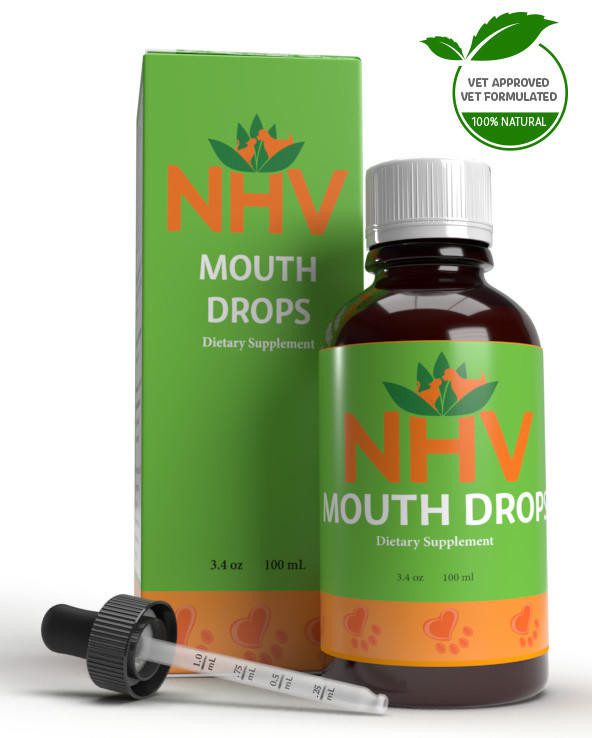
free shipping over $100 (USA & Canada)
1-877-937-4372 the pet expert hotline
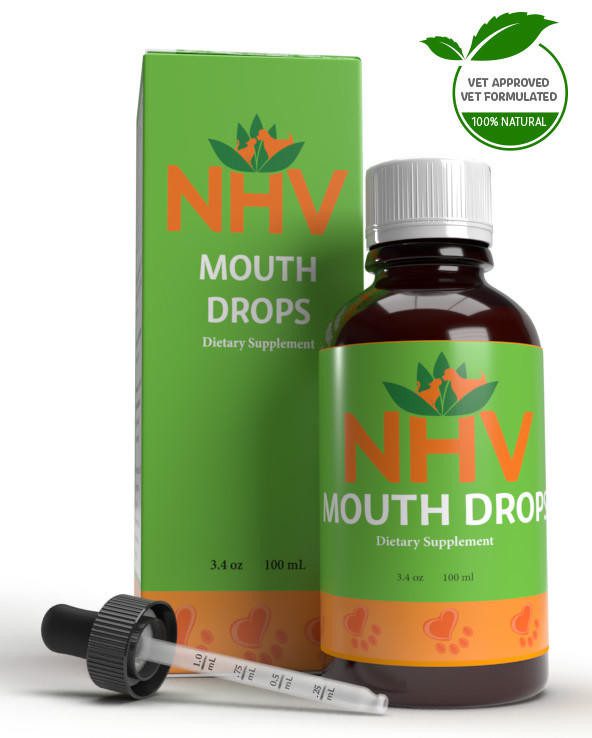
Holistic Support for Gingivitis, Gum Disease & Periodontal Disease in Dogs

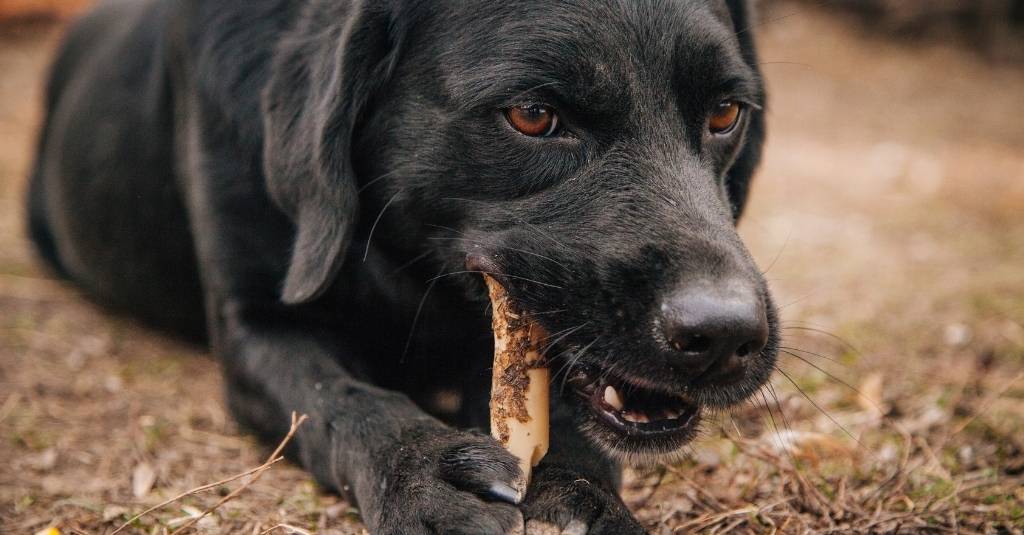
Most dogs can’t resist a good chew. Many dog owners turn to bones and sticks to keep their pets entertained. Although dog’s wild ancestors did chew and eat bones of their prey and possibly even chewed on sticks, it is not advisable to allow your pup to chew bones and sticks for a variety of reasons. Your pup’s wild dog ancestors would not have had the luxury of visiting a doctor should anything go wrong!
‘Soup Bones’ are quite dangerous, even if they aren’t splintered and ingested.
Bones, whether raw or cooked, can break or splinter and be swallowed by our dogs. If your dog manages to swallow the bone fragments without choking, the bone then has to safely make it through their digestive tract. This is not impossible, but it is quite risky. Bone fragments can be too large to pass through the pyloric sphincter (the exit from the stomach to the small intestine) or they may become lodged along the way through the intestinal tract. This would cause your pup to get quite sick, and likely require an exploratory surgery or gastric endoscopy. Perforation of the bowels can lead to peritonitis, a deadly infection of the abdominal cavity.
‘Soup Bones’ are quite dangerous, even if they aren’t splintered and ingested. A common emergency we have seen in clinics is a soup bone stuck around the bottom jaw of a dog, stuck behind the lower canine teeth. Often a dog will need sedation in order to remove the bone (the dog pictured is sedated) Though this problem is not inherently dangerous on its own, because it is quite obvious and caught quickly by owners, it can lead the dog to panic, causing injury to themselves or their owner. Never, ever leave your pet unattended with any type of bone!
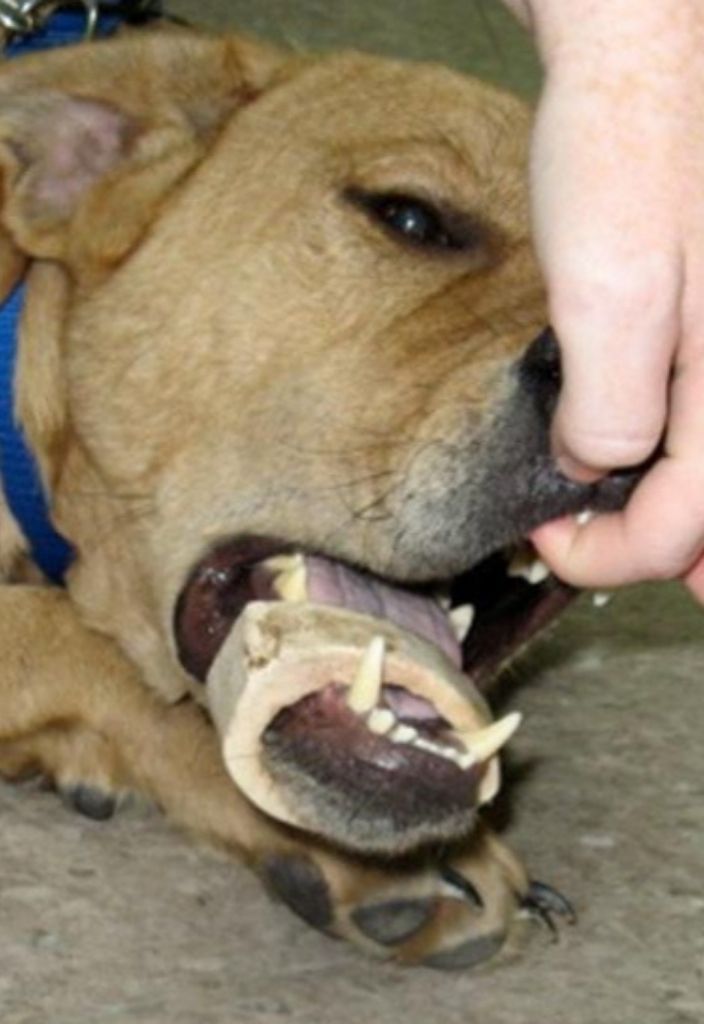
Another popular make-shift toys for dogs are sticks. Many dogs love lying in the grass on a warm summer day, gnashing on a good stick. While playing fetch with a stick can be quite harmless, chewing on a stick can be quite the opposite. On quite a few occasions we have seen frantic owners come into the clinic saying that something is wrong with their dog’s mouth. The dog is drooling, panicking, and wildly pawing at their mouth. A quick oral exam reveals a stick, which has been clamped down on with their teeth, now wedged perfectly along the palate between the upper premolars. Though this is usually a quick and simple fix, it can be quite traumatizing to both the dog and the owners. We have also heard of instances where the stick was not a bother to the dog and only found much later after it began to cause trauma and infection.

Both stick and bone fragments can easily become lodged between two teeth and not be noticed by the dog’s owners. The only sign that something isn’t quite right may be a foul odor coming from the dog’s mouth, which some owners just mistake for typical ‘doggy breath’.
In the example below, the dog had been an avid stick chewer. When his breath became so bad the owner could not take it anymore, a thorough oral examination was done. A stick fragment was found between the lower premolar and molar. It had been there for so long that it had created a very large gap between the two teeth, which normally contact one another. The molar’s root was exposed, and unfortunately, it required extraction
.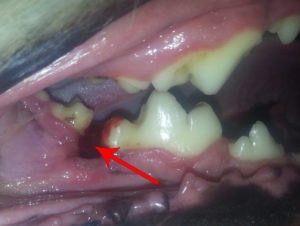
In the example below, again, the indication that something was amiss was foul-smelling breath. After the dog was sedated, a large lesion was noted in the dog’s lower jaw, alongside the teeth. With some exploration, the doctor was able to remove this 2.5-inch long fragment of either a stick or a bone. It was difficult to tell which, because it was so degraded, and the owners said the dog was an avid chewer of both.
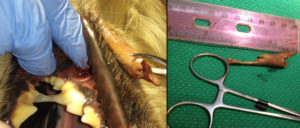
There are many great alternatives to bones and sticks that can keep your pup just as happy such as Kongs, Nylabones, and even safe, realistic stick substitutes. Always remember to supervise your pet while chewing any toy and dispose of any toys which may be damaged and cause injury.
If your pet is suffering from unusually foul breath. It is important to have a veterinarian perform a thorough oral examination. If no problems aside from gingivitis are found, you may be able to help your pets bad breath with NHV Mouth Drops
Oral Care

Herbal Mouth Drops for Pets
buy 2 and save $3
3 month supply for a small to medium size pet.
What is it?
A natural herbal oral supplement that aids in eliminating bad breath, gingivitis, and helps combat bacterial infections of the mouth and helps guard against tooth decay and plaque.
How does it work?
Why should I trust it?
NHV supplements are formulated by a holistic veterinarian and a master herbalist with a combined 50 years of experience.

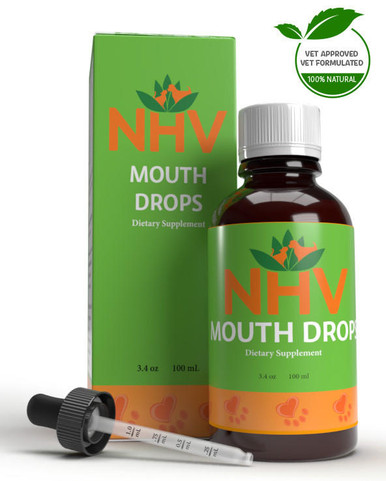
What is it?
A natural herbal oral supplement that aids in eliminating bad breath, gingivitis, and helps combat bacterial infections of the mouth and helps guard against tooth decay and plaque.
How does it work?
Why should I trust it?
NHV supplements are formulated by a holistic veterinarian and a master herbalist with a combined 50 years of experience.

Does your pet have morning breath that lasts all day long? Mouth Drops from NHV Natural Pet Products are like a mouthwash for pets that helps eliminate bad breath, helps gingivitis, combats bacterial infections, and fight your pet's tooth decay and other dental problems. Use in combination with a nutritious diet and regular brushing to maintain the health of your pet’s teeth.
Mouth Drops may be beneficial for these conditions:
Additional Support:
Never attempt to diagnose a pet. A vet will be able to perform the required test and make the necessary suggestion.
White Oak – White oak is a type of hardwood tree native to eastern and central North America. It is traditionally used as an antiseptic, astringent, and anti-inflammatory herb. It has antiviral, antilithic, and astringent properties that control pain, inflammation, and help control bleeding.
Plantain – Plantain is an astringent, antibacterial, demulcent, emollient and anti-inflammatory herb. It has expectorant properties that soothe and lubricate internal mucous membranes, and helps stop bleeding.
Sage – Sage is often recommended as an antiseptic, and is commonly used for infections or sores of the mouth as well as topically for pets with gingivitis. It has anti-fungal, antiviral, astringent, diaphoretic and carminative properties. It also contains essential oils with antibacterial properties that neutralize mouth odor.
Echinacea Angustifolia – Commonly used for infections, Echinacea Angustifolia contains many active chemicals such as polysaccharides, flavonoids, caffeic acid, essential oils, alkylamides and polyacetylenes that have strong immune-stimulating (antiviral and antibacterial) properties.
Myrrh – It strengthens and activates the immune system and helps fight infections. It helps soothe inflamed gums, canker sores, loose teeth, and eliminates bad breath.
Neem – Neem has antibacterial, anti-fungal, anti-inflammatory, analgesic, and alterative properties, and is also high in antioxidants. Studies have found that it helps reduce plaque build up, defends against microorganisms, helps with gum bleeding, and reduces bacteria and bad breath.
Select your pet's weight to determine the correct dose.
Topically: To be taken twice daily. 1 drop for every 2 lb of body weight twice a day up to 50 lb. This is the minimum dosage.
Using the dropper squirt the dosage along teeth and gums.
Orally: To be taken twice daily. Determine your pet’s weight and then use the easy chart below to determine the correct dose. This is the minimum dosage.
Pet's Weight Dosage
0 - 15 lb = 0.5 ml
16 - 30 lb = 1.0 ml
31 - 45 lb = 1.5 ml
46 - 60 lb = 2.0 ml
61 - 75 lb = 2.5 ml
Over 75 lb = 3.0 ml
Some pets may require a larger dosage due to their metabolism. You can safely double the recommended dosage.
How to Administer
Shake well before use. Use the dropper provided to squirt the dosage directly into your pet’s mouth along the gums and teeth.. Some pets may be finicky and resist your attempts to administer drops directly into their mouth. If this occurs, try placing the drops in your pet’s food or favourite treat. You may want to consider hiding the drops in foods most pet’s love such as fish, chicken, or yogurt. When serving dry food, use the dropper to soak a few kibbles at feeding time.
For Best Results
Herbal dietary supplements are beneficial to the health and wellbeing of your pet and are safe for long-term use. Every pet responds to natural herbal supplements differently, therefore it is important to be consistent and administer the product daily. Supplements generally take two to four weeks to take effect, however this will vary from one animal to the next.
Product Storage
All NHV Natural Pet Products are pure herbal extracts and contain no artificial additives, preservatives or coloring. Shelf life after opening is 6 months and must be refrigerated after opening.
Cautions and Contraindications
Do not use Mouth Drops in pregnant or nursing animals. Speak to your vet before using our products. A second visit is recommended if your pet’s condition does not improve, or deteriorates after continued use of the supplements.
All information provided by NHV Natural Pet Products is for educational purposes only.
Does your pet have morning breath that lasts all day long? Mouth Drops from NHV Natural Pet Products are like a mouthwash for pets that helps eliminate bad breath, helps gingivitis, combats bacterial infections, and fight your pet's tooth decay and other dental problems. Use in combination with a nutritious diet and regular brushing to maintain the health of your pet’s teeth.
Mouth Drops may be beneficial for these conditions:
Additional Support:
Never attempt to diagnose a pet. A vet will be able to perform the required test and make the necessary suggestion.
White Oak – White oak is a type of hardwood tree native to eastern and central North America. It is traditionally used as an antiseptic, astringent, and anti-inflammatory herb. It has antiviral, antilithic, and astringent properties that control pain, inflammation, and help control bleeding.
Plantain – Plantain is an astringent, antibacterial, demulcent, emollient and anti-inflammatory herb. It has expectorant properties that soothe and lubricate internal mucous membranes, and helps stop bleeding.
Sage – Sage is often recommended as an antiseptic, and is commonly used for infections or sores of the mouth as well as topically for pets with gingivitis. It has anti-fungal, antiviral, astringent, diaphoretic and carminative properties. It also contains essential oils with antibacterial properties that neutralize mouth odor.
Echinacea Angustifolia – Commonly used for infections, Echinacea Angustifolia contains many active chemicals such as polysaccharides, flavonoids, caffeic acid, essential oils, alkylamides and polyacetylenes that have strong immune-stimulating (antiviral and antibacterial) properties.
Myrrh – It strengthens and activates the immune system and helps fight infections. It helps soothe inflamed gums, canker sores, loose teeth, and eliminates bad breath.
Neem – Neem has antibacterial, anti-fungal, anti-inflammatory, analgesic, and alterative properties, and is also high in antioxidants. Studies have found that it helps reduce plaque build up, defends against microorganisms, helps with gum bleeding, and reduces bacteria and bad breath.
Select your pet's weight to determine the correct dose.
Topically: To be taken twice daily. 1 drop for every 2 lb of body weight twice a day up to 50 lb. This is the minimum dosage.
Using the dropper squirt the dosage along teeth and gums.
Orally: To be taken twice daily. Determine your pet’s weight and then use the easy chart below to determine the correct dose. This is the minimum dosage.
Pet's Weight Dosage
0 - 15 lb = 0.5 ml
16 - 30 lb = 1.0 ml
31 - 45 lb = 1.5 ml
46 - 60 lb = 2.0 ml
61 - 75 lb = 2.5 ml
Over 75 lb = 3.0 ml
Some pets may require a larger dosage due to their metabolism. You can safely double the recommended dosage.
How to Administer
Shake well before use. Use the dropper provided to squirt the dosage directly into your pet’s mouth along the gums and teeth.. Some pets may be finicky and resist your attempts to administer drops directly into their mouth. If this occurs, try placing the drops in your pet’s food or favourite treat. You may want to consider hiding the drops in foods most pet’s love such as fish, chicken, or yogurt. When serving dry food, use the dropper to soak a few kibbles at feeding time.
For Best Results
Herbal dietary supplements are beneficial to the health and wellbeing of your pet and are safe for long-term use. Every pet responds to natural herbal supplements differently, therefore it is important to be consistent and administer the product daily. Supplements generally take two to four weeks to take effect, however this will vary from one animal to the next.
Product Storage
All NHV Natural Pet Products are pure herbal extracts and contain no artificial additives, preservatives or coloring. Shelf life after opening is 6 months and must be refrigerated after opening.
Cautions and Contraindications
Do not use Mouth Drops in pregnant or nursing animals. Speak to your vet before using our products. A second visit is recommended if your pet’s condition does not improve, or deteriorates after continued use of the supplements.
All information provided by NHV Natural Pet Products is for educational purposes only.
stress & anxiety support
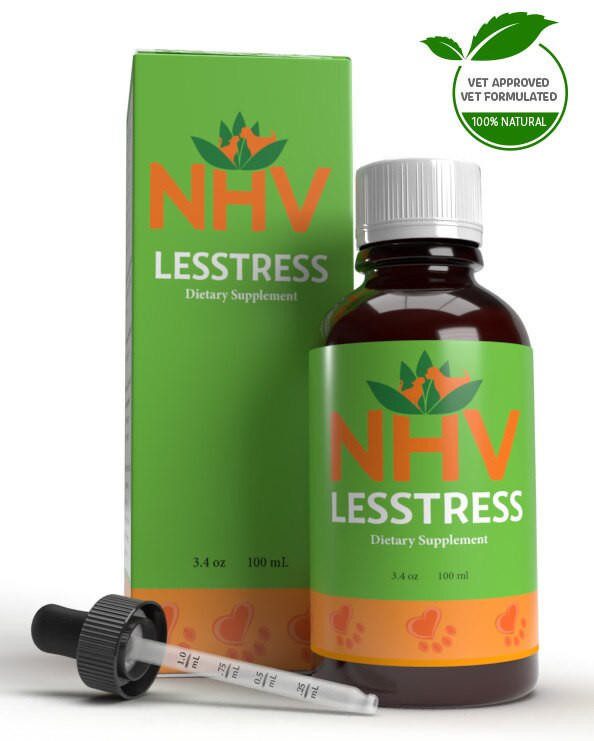
Natural Support for Canine Stress and Anxiety
buy 2 and save $3
3 month supply for a small to medium size pet
What is it?
Everyone knows what stress feels like, and we all know that too much stress can make us ill—high blood pressure, ulcers and even cancer can result from excessive stress. Like us, dogs can get stressed by numerous factors as well. Help your furkiddo relax into a long and happy life with NHV Lesstress - a natural dog stress support.
How does it work?
Why trust it?
NHV uses full-spectrum extracts of human-grade herbs, so your pet only gets the best.

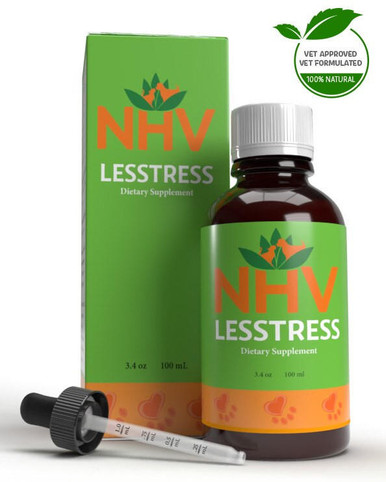
What is it?
Everyone knows what stress feels like, and we all know that too much stress can make us ill—high blood pressure, ulcers and even cancer can result from excessive stress. Like us, dogs can get stressed by numerous factors as well. Help your furkiddo relax into a long and happy life with NHV Lesstress - a natural dog stress support.
How does it work?
Why trust it?
NHV uses full-spectrum extracts of human-grade herbs, so your pet only gets the best.

Natural Dog Stress Reliever Supplemental Support
With a heightened sense of hearing and smell, small events that seem mundane to us can be terrifying and stressful for your dogs. Sometimes the stress is from the ride to the office, or maybe they are missing their human companions. This all contributes to changes in behavior like excessive panting, drooling, sweaty paws, dilated eyes, pacing, excessively shedding, or just completely shutting down. Some dogs become so stressed that it may lead to fear and aggression.
Other forms of stress in a dog’s life include:
In addition to panting, excessive barking/whining, chewing on themselves, shivering (when it’s not cold), panicked tail wagging, or tense muscles, stress can also cause GI tract issues such as diarrhea or vomiting.
The key to a healthy pup is balance. Too much or too little activity can be harmful, as well as too much or too little socialization. A balanced, clean diet also helps maintain the body and the mind. If your dog is susceptible to stress, you can use calming herbs like those found in NHV Lesstress. This formulation gently acts on the nervous system and immune system to provide a natural dog stress reliever.
How NHV’s Natural Dog Stress Relief Eases Stress and Anxiety
For stressful experiences such as separation anxiety, the loss or addition of a furry friend, special events (eg. fireworks) and illness (stress can cause conditions to worsen), the natural (non-addictive) sedative properties of Lesstress gently relax the nervous system and endocrine system. Ingredients like Chamomile, Passion Flower and Lemon Balm work to calm nerves while ingredients like Reishi, Eleuthero, and Echinacea Angustifolia are very beneficial for helping the body adapt to stress and illness and stimulate healthy immune function.
Help Support Your Dog Naturally
All NHV supplements like Lesstress are 100% natural and created by a holistic veterinarian and a master herbalist, specially formulated for pets. Feel free to contact our veterinary professionals to get more insight into your little one’s health and wellbeing.
Made with the finest, organically grown, or ethically harvested herbs. Made specifically for pets, vet-formulated and vet approved.
Lesstress for Dogs
Select your pet's weight to determine the correct dose.
To be taken twice daily. Determine your pet’s weight and then use the easy chart below to determine the correct dose. This is the minimum dosage.
Pet's Weight Dosage
0 - 15 lb = 0.5 ml
16 - 30 lb = 1.0 ml
31 - 45 lb = 1.5 ml
46 - 60 lb = 2.0 ml
61 - 75 lb = 2.5 ml
Over 75 lb = 3.0 ml
For small animals (rabbits, ferrets), avians and reptiles use 1 drop for every 2 lb of body weight.
How to Administer
Shake well before use.
The easiest method is to use the dropper provide and places the drops into your pet’s food or favorite treat. You can also use the dropper and squirt directly into the pet’s mouth.
Some pets can be finicky, if this occurs consider hiding the drops in foods most pet’s love such as fish, chicken or yogurt or a favourite treat. If your pet only eats dry food then soak a few kibbles at feeding time.
For Best Results
Herbal dietary supplements are beneficial to the health and wellbeing of your pet and are safe for long-term use. Every pet responds to natural herbal supplements differently, therefore it is important to be consistent and administer the product daily. Supplements generally take two to four weeks to take effect, however this will vary from one animal to the next.
Product Storage
All NHV Natural Pet Products are pure herbal extracts and contain no artificial additives, preservatives or coloring. Shelf life after opening is 6 months and must be refrigerated after opening.
Cautions and Contraindications
Do not use Lesstress in pregnant or nursing animals.
Speak to your vet before using our products. A second visit is recommended if your pet’s condition does not improve, or deteriorates after continued use of the supplements.
All information provided by NHV Natural Pet Products is for educational purposes only.
Natural Dog Stress Reliever Supplemental Support
With a heightened sense of hearing and smell, small events that seem mundane to us can be terrifying and stressful for your dogs. Sometimes the stress is from the ride to the office, or maybe they are missing their human companions. This all contributes to changes in behavior like excessive panting, drooling, sweaty paws, dilated eyes, pacing, excessively shedding, or just completely shutting down. Some dogs become so stressed that it may lead to fear and aggression.
Other forms of stress in a dog’s life include:
In addition to panting, excessive barking/whining, chewing on themselves, shivering (when it’s not cold), panicked tail wagging, or tense muscles, stress can also cause GI tract issues such as diarrhea or vomiting.
The key to a healthy pup is balance. Too much or too little activity can be harmful, as well as too much or too little socialization. A balanced, clean diet also helps maintain the body and the mind. If your dog is susceptible to stress, you can use calming herbs like those found in NHV Lesstress. This formulation gently acts on the nervous system and immune system to provide a natural dog stress reliever.
How NHV’s Natural Dog Stress Relief Eases Stress and Anxiety
For stressful experiences such as separation anxiety, the loss or addition of a furry friend, special events (eg. fireworks) and illness (stress can cause conditions to worsen), the natural (non-addictive) sedative properties of Lesstress gently relax the nervous system and endocrine system. Ingredients like Chamomile, Passion Flower and Lemon Balm work to calm nerves while ingredients like Reishi, Eleuthero, and Echinacea Angustifolia are very beneficial for helping the body adapt to stress and illness and stimulate healthy immune function.
Help Support Your Dog Naturally
All NHV supplements like Lesstress are 100% natural and created by a holistic veterinarian and a master herbalist, specially formulated for pets. Feel free to contact our veterinary professionals to get more insight into your little one’s health and wellbeing.
Made with the finest, organically grown, or ethically harvested herbs. Made specifically for pets, vet-formulated and vet approved.
Lesstress for Dogs
Select your pet's weight to determine the correct dose.
To be taken twice daily. Determine your pet’s weight and then use the easy chart below to determine the correct dose. This is the minimum dosage.
Pet's Weight Dosage
0 - 15 lb = 0.5 ml
16 - 30 lb = 1.0 ml
31 - 45 lb = 1.5 ml
46 - 60 lb = 2.0 ml
61 - 75 lb = 2.5 ml
Over 75 lb = 3.0 ml
For small animals (rabbits, ferrets), avians and reptiles use 1 drop for every 2 lb of body weight.
How to Administer
Shake well before use.
The easiest method is to use the dropper provide and places the drops into your pet’s food or favorite treat. You can also use the dropper and squirt directly into the pet’s mouth.
Some pets can be finicky, if this occurs consider hiding the drops in foods most pet’s love such as fish, chicken or yogurt or a favourite treat. If your pet only eats dry food then soak a few kibbles at feeding time.
For Best Results
Herbal dietary supplements are beneficial to the health and wellbeing of your pet and are safe for long-term use. Every pet responds to natural herbal supplements differently, therefore it is important to be consistent and administer the product daily. Supplements generally take two to four weeks to take effect, however this will vary from one animal to the next.
Product Storage
All NHV Natural Pet Products are pure herbal extracts and contain no artificial additives, preservatives or coloring. Shelf life after opening is 6 months and must be refrigerated after opening.
Cautions and Contraindications
Do not use Lesstress in pregnant or nursing animals.
Speak to your vet before using our products. A second visit is recommended if your pet’s condition does not improve, or deteriorates after continued use of the supplements.
All information provided by NHV Natural Pet Products is for educational purposes only.
seasonal support
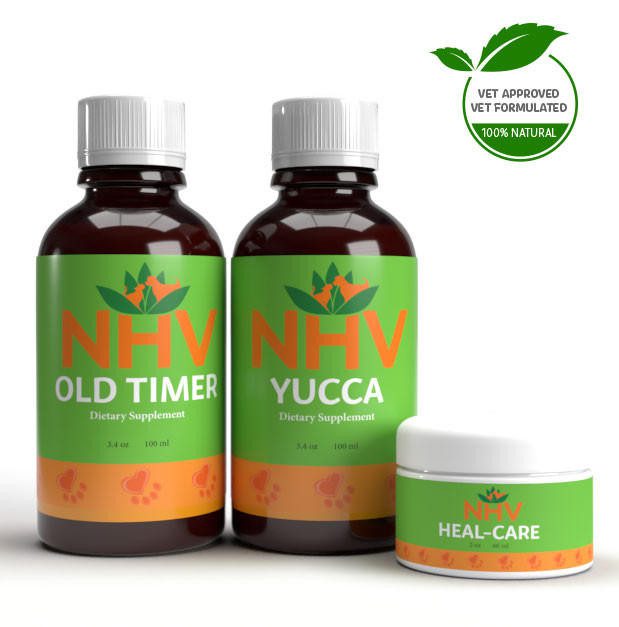
Old Timer, Yucca & Heal Care Ointment
bundle and save with pet expert kits
3 month supply for a small to medium size
What is it?
As the weather dampens and cools down, you're not the only one who's feeling a sudden chill in their bones—pets can be especially vulnerable to joint pain during colder fall and winter months. Give your furkiddo the support they deserve with NHV’s Winter Health Kit.
How does it work?
Why trust it?
NHV supplements are vet-formulated and vet-approved.

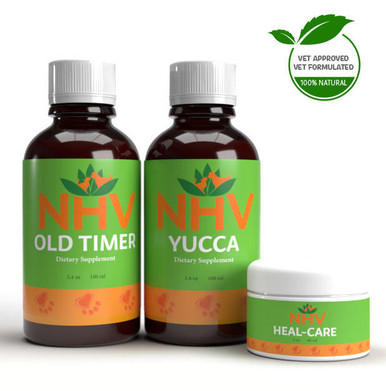
What is it?
As the weather dampens and cools down, you're not the only one who's feeling a sudden chill in their bones—pets can be especially vulnerable to joint pain during colder fall and winter months. Give your furkiddo the support they deserve with NHV’s Winter Health Kit.
How does it work?
Why trust it?
NHV supplements are vet-formulated and vet-approved.

When the weather changes, it isn't just us that notices! Our pets feel it too! During colder fall and winter months, your furkiddo may be especially vulnerable to joint inflammation, arthritic flare-ups, bruises, cuts and paw pad injuries. As their pet pawrent, you may notice them acting a little differently, for example, if your dog or cat's joints are sore, they may have difficulty going to the bathroom normally. And in many places that deal with ice and snow in colder months, the salt on the roads may further aggravate your pet. Salt can really dry out and crack the skin on their paw pads, or worse, the salt is licked and ingested, causing salt poisoning. Signs of salt poisoning are drooling, loss of appetite, vomiting, and diarrhea. More severe cases of salt poisoning may lead to seizures, comas, and even death. We highly recommend washing your pet's paws with warm soapy water after wintery romps to prevent salt from irritating the skin. Once the paws are clean and dry, NHV Heal Care is a beneficial dog paw balm and cat paw balm for adding moisture back into the skin and creating a protective barrier against the elements. To provide internal support from the elements, Old Timer and Yucca round out the Winter Health Kit to help soothe inflammation in the muscles and joints, help revitalize energy levels and add immune support so that our furry friends are protected inside and out!
You may notice small changes in your dog or cat's behavior when they aren't feeling their best. Arthritis in cats and dogs can become more noticeable in the winter, as colder temperatures may increase joint discomfort—just like in humans.
And then the added issue of road salt in colder months may cause further stress and discomfort. As their paw parent, you will want to reduce swelling and inflammation, improve circulation and support their immune system so that they can bounce back and get outside! NHV Winter Health Kit contains Old Timer, Yucca, and Heal Care. Old Timer's blend of nutrient-rich herbs is beneficial for immune support, improving energy levels and helping the body deal with stress. Ingredients like asian ginseng have a long history of being used to improve overall vitality, energy levels and muscle strength. Yucca contains natural steroid-like properties that help alleviate inflammation and encourage healthy appetite. And St. John's wort combined with arnica in Heal Care provide a soothing cat and dog pawbalm to support the healing of bruises, cuts, inflamed paw pads, sore muscles and more.
It’s great to know that there are ways to support your little one’s health naturally! All NHV products use only the finest organic, wild-crafted ingredients and formulated by the combined efforts of a master herbalist and veterinarian with 50+ years of experience. If you have any questions about cat and dog joint supplements or need any holistic advice, an NHV pet expert is happy to help.
Made with the finest, organically grown, or ethically harvested herbs. Made specifically for pets, vet-formulated, and vet approved.
Old Timer
Yucca
Heal Care
Select your pet's weight to determine the correct dose.
All NHV natural pet supplements can be used together simultaneously.
DIRECTIONS AND DOSAGE FOR NHV YUCCA AND NHV OLD TIMER
To be taken twice daily. Determine your pet’s weight and then use the easy chart below to determine the correct dose. This is the minimum dosage.
Pet's Weight Dosage
0 - 15 lb = 0.5 ml
16 - 30 lb = 1.0 ml
31 - 45 lb = 1.5 ml
46 - 60 lb = 2.0 ml
61 - 75 lb = 2.5 ml
Over 75 lb = 3.0 ml
For small animals (rabbits, ferrets), avians and reptiles use 1 drop for every 2 lb of body weight.
How to Administer
Shake well before use. The easiest method is to use the dropper provide and places the drops into your pet’s food or favorite treat. You can also use the dropper and squirt directly into the pet’s mouth.
Some pets can be finicky, if this occurs consider hiding the drops in foods most pet’s love such as fish, chicken or yogurt or a favourite treat. If your pet only eats dry food then soak a few kibbles at feeding time.
For Best Results
Herbal dietary supplements are beneficial to the health and wellbeing of your pet and are safe for long-term use. Every pet responds to natural herbal supplements differently, therefore it is important to be consistent and administer the product daily. Supplements generally take two to four weeks to take effect, however this will vary from one animal to the next.
Product Storage
All NHV Natural Pet Products are pure herbal extracts and contain no artificial additives, preservatives or coloring. Shelf life after opening is 6 months and must be refrigerated after opening.
Cautions and Contraindications
Do not in pregnant or nursing animals. Speak to your vet before using our products. A second visit is recommended if your pet’s condition does not improve, or deteriorates after continued use of the supplements.
DIRECTIONS AND DOSAGE FOR NHV HEAL CARE OINTMENT
How to Administer
Topical ointment: Clean and dry paw pads. Apply to affected area 3 to 4 times per day until healed. It may be necessary to use booties or wrap the paw with gauze dressing so that your pet does not lick the ointment.
Caution
Do not apply on open or bleeding wounds. Heal Care ointment contains arnica which may cause a skin allergy on some very sensitive pet’s. Try the product on a hairless part of the body first to test for sensitivity
All information provided by NHV Natural Pet Products is for educational purposes only.
When the weather changes, it isn't just us that notices! Our pets feel it too! During colder fall and winter months, your furkiddo may be especially vulnerable to joint inflammation, arthritic flare-ups, bruises, cuts and paw pad injuries. As their pet pawrent, you may notice them acting a little differently, for example, if your dog or cat's joints are sore, they may have difficulty going to the bathroom normally. And in many places that deal with ice and snow in colder months, the salt on the roads may further aggravate your pet. Salt can really dry out and crack the skin on their paw pads, or worse, the salt is licked and ingested, causing salt poisoning. Signs of salt poisoning are drooling, loss of appetite, vomiting, and diarrhea. More severe cases of salt poisoning may lead to seizures, comas, and even death. We highly recommend washing your pet's paws with warm soapy water after wintery romps to prevent salt from irritating the skin. Once the paws are clean and dry, NHV Heal Care is a beneficial dog paw balm and cat paw balm for adding moisture back into the skin and creating a protective barrier against the elements. To provide internal support from the elements, Old Timer and Yucca round out the Winter Health Kit to help soothe inflammation in the muscles and joints, help revitalize energy levels and add immune support so that our furry friends are protected inside and out!
You may notice small changes in your dog or cat's behavior when they aren't feeling their best. Arthritis in cats and dogs can become more noticeable in the winter, as colder temperatures may increase joint discomfort—just like in humans.
And then the added issue of road salt in colder months may cause further stress and discomfort. As their paw parent, you will want to reduce swelling and inflammation, improve circulation and support their immune system so that they can bounce back and get outside! NHV Winter Health Kit contains Old Timer, Yucca, and Heal Care. Old Timer's blend of nutrient-rich herbs is beneficial for immune support, improving energy levels and helping the body deal with stress. Ingredients like asian ginseng have a long history of being used to improve overall vitality, energy levels and muscle strength. Yucca contains natural steroid-like properties that help alleviate inflammation and encourage healthy appetite. And St. John's wort combined with arnica in Heal Care provide a soothing cat and dog pawbalm to support the healing of bruises, cuts, inflamed paw pads, sore muscles and more.
It’s great to know that there are ways to support your little one’s health naturally! All NHV products use only the finest organic, wild-crafted ingredients and formulated by the combined efforts of a master herbalist and veterinarian with 50+ years of experience. If you have any questions about cat and dog joint supplements or need any holistic advice, an NHV pet expert is happy to help.
Made with the finest, organically grown, or ethically harvested herbs. Made specifically for pets, vet-formulated, and vet approved.
Old Timer
Yucca
Heal Care
Select your pet's weight to determine the correct dose.
All NHV natural pet supplements can be used together simultaneously.
DIRECTIONS AND DOSAGE FOR NHV YUCCA AND NHV OLD TIMER
To be taken twice daily. Determine your pet’s weight and then use the easy chart below to determine the correct dose. This is the minimum dosage.
Pet's Weight Dosage
0 - 15 lb = 0.5 ml
16 - 30 lb = 1.0 ml
31 - 45 lb = 1.5 ml
46 - 60 lb = 2.0 ml
61 - 75 lb = 2.5 ml
Over 75 lb = 3.0 ml
For small animals (rabbits, ferrets), avians and reptiles use 1 drop for every 2 lb of body weight.
How to Administer
Shake well before use. The easiest method is to use the dropper provide and places the drops into your pet’s food or favorite treat. You can also use the dropper and squirt directly into the pet’s mouth.
Some pets can be finicky, if this occurs consider hiding the drops in foods most pet’s love such as fish, chicken or yogurt or a favourite treat. If your pet only eats dry food then soak a few kibbles at feeding time.
For Best Results
Herbal dietary supplements are beneficial to the health and wellbeing of your pet and are safe for long-term use. Every pet responds to natural herbal supplements differently, therefore it is important to be consistent and administer the product daily. Supplements generally take two to four weeks to take effect, however this will vary from one animal to the next.
Product Storage
All NHV Natural Pet Products are pure herbal extracts and contain no artificial additives, preservatives or coloring. Shelf life after opening is 6 months and must be refrigerated after opening.
Cautions and Contraindications
Do not in pregnant or nursing animals. Speak to your vet before using our products. A second visit is recommended if your pet’s condition does not improve, or deteriorates after continued use of the supplements.
DIRECTIONS AND DOSAGE FOR NHV HEAL CARE OINTMENT
How to Administer
Topical ointment: Clean and dry paw pads. Apply to affected area 3 to 4 times per day until healed. It may be necessary to use booties or wrap the paw with gauze dressing so that your pet does not lick the ointment.
Caution
Do not apply on open or bleeding wounds. Heal Care ointment contains arnica which may cause a skin allergy on some very sensitive pet’s. Try the product on a hairless part of the body first to test for sensitivity
All information provided by NHV Natural Pet Products is for educational purposes only.
Published: May 11, 2018